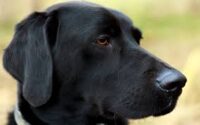A Wee problem
It has become more difficult for me to treat urinary incontinence in dogs successfully these days because like many Integrative Veterinarians in Australia, I want to cure them. This approach involves finding out why they are exhibiting this symptom and also how to apply homeopathy to strengthen them.
This can take time.
When an animal is working hard on many levels, the area that is weakest will exhibit the symptom. If a dog is protecting or caring for a family or if it is easily overwhelmed by anxiety or overwork then the area of weakness in speyed bitches is likely to be the urinary bladder. In very young animals there should be an investigation into other causes to rule out the possibility of developmental anomalies or congenital defects. Very rarely is there an infectious cause for this condition and if any bacteria are found they are almost certainly secondary to the incontinence. Nevertheless it is prudent to conduct a full urinary tract examination and urinalysis on these dogs to maximize treatment options.
In the old days of my conventional practice life I would give incontinent desexed female dogs stilboestrol tablets and this would fix 90% or more of them. This tablet is an oestrogen analogue with some testosterone activity and works on the premise that the animal is oestrogen deficient from speying, which they usually are.
One problem with this approach is that some of these dogs develop spey incontinence very early in life and a lifetime use of stilboestrol is potentially dangerous to health. They are prone to developing blood dyscrasias and becoming attractive to male dogs again. Hormone replacement therapy has many setbacks yet to be fully recognised or appreciated but recent discovery of the link to lutenising hormone overload in speyed bitches and the subsequent health issues this causes is leading to better options including ovary sparing spey procedures and the trial of gonadotropin releasing hormone supplements.

Over the years there have been a number of other products developed by pharmaceutical companies since it is a worthwhile investment given that desexing has become compulsory in many states. I happen to object to compulsory desexing on a number of grounds with health and long term growth and developmental issues being at the forefront of my concern. I recommend desexing them later in life if required or using the gonad sparing techniques.
Given that it is not practical, nor desirable in many situations to keep bitches entire and also that many of them arrive to families after they have been speyed, there must be other options available for managing this pesky condition.
Some of the pharmaceutical options also don’t work in some cases so there are a number of reasons for looking for alternative approaches. There also does not appear to be a lot of evidence that keeping them entire for a while will prevent the problem once they are eventually desexed although I do think it helps them to be mature before desexing. I have also spoken about ovary sparing technique which is an added benefit for preventing urinary incontinence, amongst other things.
Without sounding like a stuck record I have to mention that it is possible to cure this condition in some dogs simply by strengthening them by feeding a natural diet. Nothing you buy cooked in rolls, cans or packets is natural.
Never underestimate how important it is to the health of your pet to feed it properly. Chewing species appropriate diets sends chemical messages to the brain to keep animals strong in their entirety.

The other important factor that is coming to light in treating urinary incontinence in dogs is patience. We are too used to ‘quick fixes’ and with drugs we often get a quick effect, which makes us think that cure should also be rapid. However, these drugs are not curing. They are using the parts of the animal that are healthy such as the liver, immune, nervous and circulatory systems to suppress or change the parts that are not, such as the urinary bladder sphincter in this particular example. Herbal remedies may give fast results for similar reasons and may actually help to strengthen the animal but anyone who has used homeopathy will know that this is the best option to cure because it does not rely on any other organs of the body to be effective. It may take longer and that can be frustrating but it is the only medicine apart from time and the animal’s inherent vitality that can bring about true cure if cure is possible. It is difficult to properly replace hormones or other essential elements the body needs as well as nature can achieve but homeopathy can be an effective tool to help these natural health affirming processes when all factors are considered.

A homeopath will need to identify all the factors contributing to the disease as for the most part the owner will understandably be overly focused on the incontinence.
It is the most obvious and frustrating symptom but there will be others even if it is only a matter of lifestage, juvenile or elderly. Older animals are likely to have other symptoms that can help to form a remedy picture and assist selection of the most likely medicine to use for treatment. As with all homeopathic medicines there are pathophysiological, constitutional, miasmatic or situational approaches to remedy selection and if we can get as much correlation in these as possible we can have a better result.
To be in balance is to have all these factors in harmony and whilst it can appear that there is nothing else ‘wrong’, there will always be some reason why incontinence persists in intractable cases. This will be the key to remedy selection. There is always a cause even if that is difficult to remedy.
The difficulty is adding strength selectively to an area that is dependent upon a number of factors to function properly especially when there are other issues like anxiety, excitability or demand for energy in other areas of the animal’s life, irrespective of age. As with all cases of disease, a constitutional approach should yield best results but miasmatic medicines should never be overlooked in one -sided cases.
The main thing is to never give up on the idea of cure and to think broadly in approach to therapy. We do owe them that much since we have probably caused the problem in the first instance.

233
I do not give up,
I never give up,
For there is nothing
In this entire world
That is irrevocably unchangeable.
Sri Chinmoy, Twenty-Seven Thousand Aspiration-Plants, part 3, Agni Press, 1983
8192
Never give up,
No matter how long
You have to suffer
From an uncertainty-mind!
Sri Chinmoy, Seventy-Seven Thousand Service-Trees, part 9, Agni Press, 1998
8966
There is no calamity
That cannot be cured.
Sri Chinmoy, Seventy-Seven Thousand Service-Trees, part 49, Agni Press, 2008